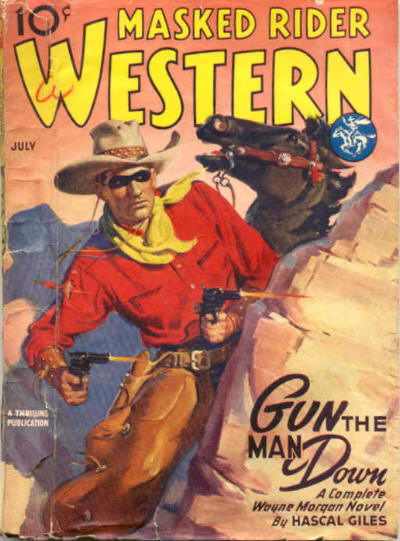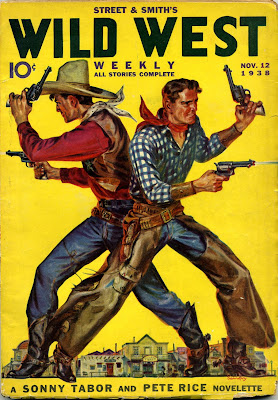Westerns
It’s hard to imagine, but according to pulp magazine historian Don Hutchison, from the 1930s into the ’50s, there were at least “184 separate magazines devoted exclusively to Western fiction”:
In magazines with titles like Blazing Western, Wild West Weekly, and Western Round-Up, legions of dusty Galahads blasted six-gun trails to pulpwood glory. Vast and forbidding, the landscape of the American frontier produced one of the most alluring blank canvases in popular culture. Pulp Westerns, with their visions of high adventure and idyllic romance set in that perilous dream world, gloried in the nostalgic appeal of the uncivilized — total escape from anything that might be crowding you. They spoke beguilingly to the homebound reader of men and women with civilization at their backs who were never afraid and never bored” (The Great Pulp Heroes, 149).
Consider what sort of demand there must have been to make it worth a publisher’s while to put out just one of these magazines every week or even every month, year after year.
Then imagine how many voracious readers there must have been to gobble up 184 different magazines. (One of them was John Walton; true to real life, in many episodes of The Waltons, you see him reading a pulp Western magazine.)

 Granted, some of those magazines probably folded after an issue or two. But others of them lasted for years. There were, for instance, Texas Rangers magazine published 206 novels about Texas Ranger Jim Hatfield in a series that lasted from 1936 to 1958 — and that, mind you, in spite of the dialogue, of which Hutchison says, “Some Western writers of the twenties and thirties considered it necessary to inflict painful cowboy slang and dialect on readers, as if their characters had studied under Gabby Hayes’ demented speech coach. Apparently, this was the way you were supposed to talk if you lived west of St. Louis” (151).
Granted, some of those magazines probably folded after an issue or two. But others of them lasted for years. There were, for instance, Texas Rangers magazine published 206 novels about Texas Ranger Jim Hatfield in a series that lasted from 1936 to 1958 — and that, mind you, in spite of the dialogue, of which Hutchison says, “Some Western writers of the twenties and thirties considered it necessary to inflict painful cowboy slang and dialect on readers, as if their characters had studied under Gabby Hayes’ demented speech coach. Apparently, this was the way you were supposed to talk if you lived west of St. Louis” (151).
Mind you, the magazines that were most successful were not necessarily the ones you might have expected:
Despite his radio and comic strip fame, The Lone Ranger’s own magazine lasted but eight issues while his blatant pulp clone, the Masked Rider (who wore a mask and palled around with an Indian companion named Blue Hawk), galloped on for over one hundred numbers. Go figure (149).

.jpg)
September 26th, 2013 at 12:31 pm
[…] the fun of it, I was reading a book about the old pulp magazines (which generated a blog entry on westerns and another on the amount of writing some pulp writers did and how much they were paid for […]